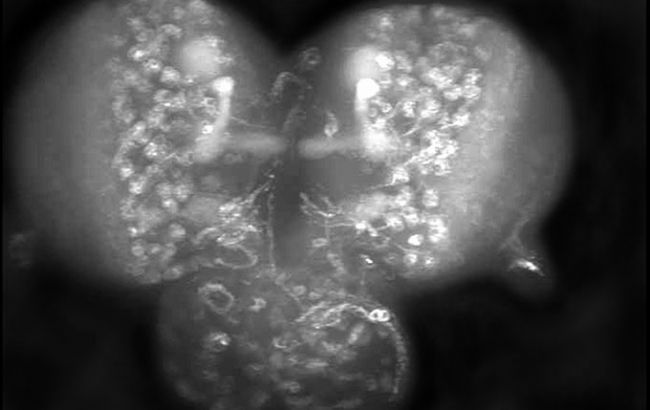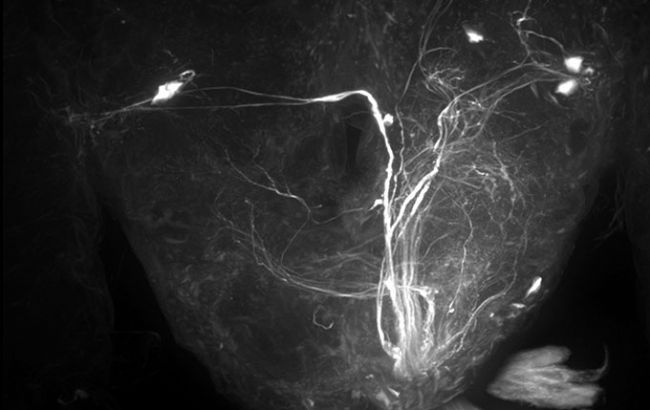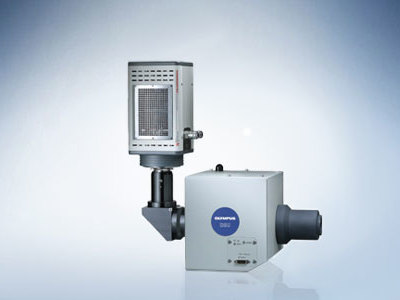The Olympus DSU (Disk Scanning Unit) represents a breakthrough in spinning disk confocal technology. The DSU disk contains a pattern of slits that creates a virtual pinhole as the disk spins at 3,000 to 5,600 rpm. Designed to optimize the trade-off between confocality and light throughput, the DSU uses either the new U-HGLGPS mercury burner or the MT20 illumination system for maximum excitation wavelength flexibility at a reasonable cost.
Look Closer, See Clearer
Putting a New Spin on Flexibility
Olympus works with its customers to develop microscopes, modules and systems that provide better solutions for microscopy, imaging and analysis processes. As a result, all Olympus microscopes are designed as “optical benches” enabling a range of modules and peripherals to be added with great ease. This drive for flexibility has led to the development of the new Olympus disk-scanning unit (DSU), which provides excellent confocal optical sectioning and motorized operation, with the added versatility of a mercury or an arc lamp excitation source. The slit disks themselves feature a unique, patent-pending design. As a result of this careful development, the Olympus DSU provides researchers with confocal images with excellent contrast and resolution compared to conventional wide field microscopy. By using arc lamp excitation sources, the Olympus DSU offers the maximum wavelength flexibility within an economical package.
The DSU Outperforms Widefield Fluorescence

Images from the same section of PtK2 cell microtubule fragments are shown. The image on the left was acquired using standard, wide field fluorescence and image on the right was acquired using the DSU confocal. Note the excellent confocal effect of the DSU including the excellent optical sectioning and removal of out of focus light, especially with thicker specimens.
3D Extended Focus Image of a Fruit Fly Brain

3D extended focus image obtained from a 230 μm thick specimen via 70 discrete z-sections at 2 μm increments.
3D Image of a Butterfly’s Central Visual Nerves

3D image obtained from a 300 μm thick specimen via 90 discrete z-sections at 2 μm increments.
Direct Confocal Observation with a Cooled CCD Camera
The Slit-Disk Optical System, Explained

An optical disk with reticular slits, called a slit disk, is placed in a conjugate position to the target focal point, and excitation light is illuminated on the sample. The signal emitted by the sample is returned through these slits to a high-sensitivity camera. Since only light from the focal plane of the sample can pass through the slits, the process removes out-of-focus information from above and below the focal plane. The rapidly spinning disk eliminates out-of-focus light from the entire acquisition range of the image.
Excellent Cost-Effective Performance
By utilizing white light sources, the DSU is more cost-effective than laser based systems and allows for pre-existing white light sources to be used (xenon or mercury lamps) without modification. As needs change, the fluorescence excitation characteristics can be easily updated by adding new filter and dichromatic mirror sets to coincide with the new fluorochromes, whereas laser-based systems often require new laser sources to accommodate additional fluorochromes. The DSU system also supports DAPI excitation in the near UV without modification. Filter-mirror sets for GFP and RFP are included.
Confocal Clarity
In conventional widefield fluorescence microscopy, the inside structure of a thick specimen cannot be observed clearly because of the significant contribution of out-of-focus light from above and below the focal plane. The DSU makes it possible to reject out-of-focus light by placing a spinning disk with an alternating pattern of vertical and horizontal slits in the confocal plane of the microscope. The slit disk spins at 3,000 - 5,600 rpm creating virtual pinholes which have an effect similar to the pinholes used in confocal laser scanning microscopy (CLSM).
The Perfect Disk for Every Purpose
Five disks are available, each with varying slit width and spacing. They offer flexibility to accommodate varied numerical apertures and specimen thicknesses for objective magnifications from 20x - 100x.
Easy Operation
Disk operation is motorized, allowing a computer to switch remotely between wide field and DSU modes. The system includes a motorized filter turret for the convenient change of fluorescence filter in DSU mode as well as a motorized filter wheel equipped with neutral density (ND) filters to maintain illumination intensity in different observation modes. The DSU can be combined with the inverted motorized microscope IX83 for 3D confocal imaging.
Advanced System Performance
Confocal 3D image stacks can be acquired easily using the Inverted IX83 microscope platform with its built-in, precise Z motor. Image acquisition software can be used to control the microscopes, the DSU and digital cameras for a very easy-to-use complete solution to your imaging needs.
A Choice of Disks for Varying Applications
Five different types of disks are available, with different slit widths to suit different objectives and specimen thicknesses. Exchanging one disk for another is easy using the provided tools.
bio-equip.cn








